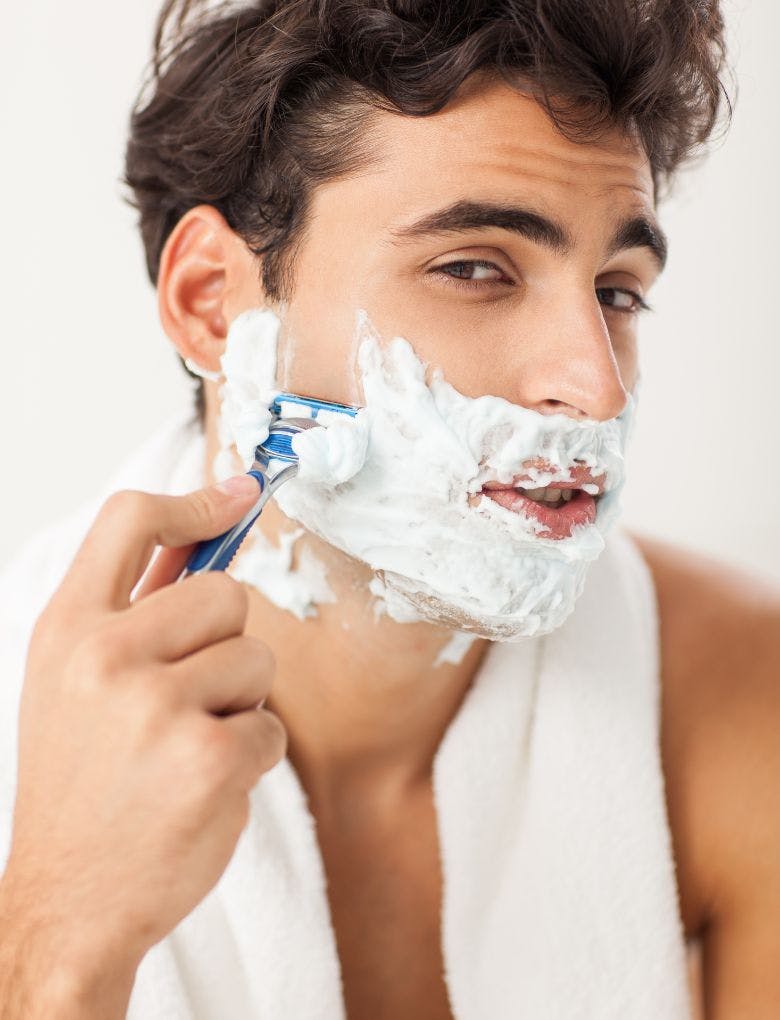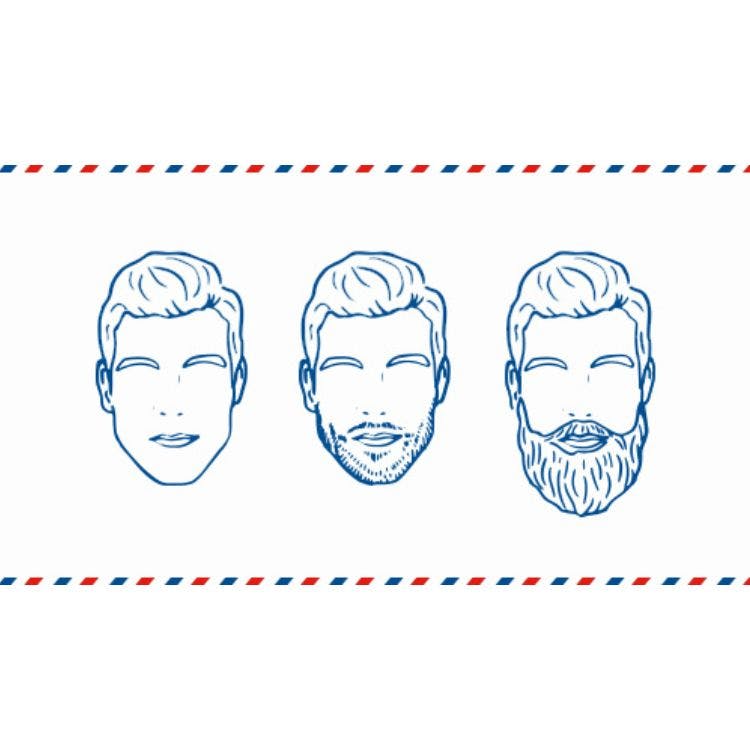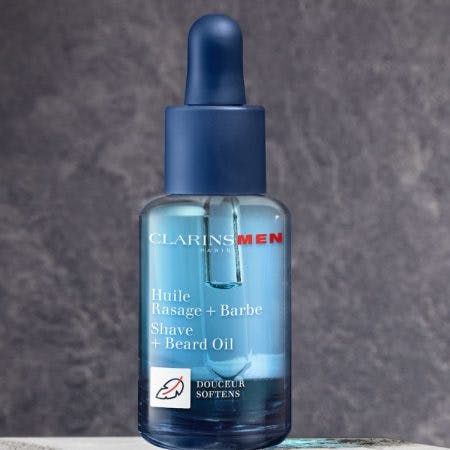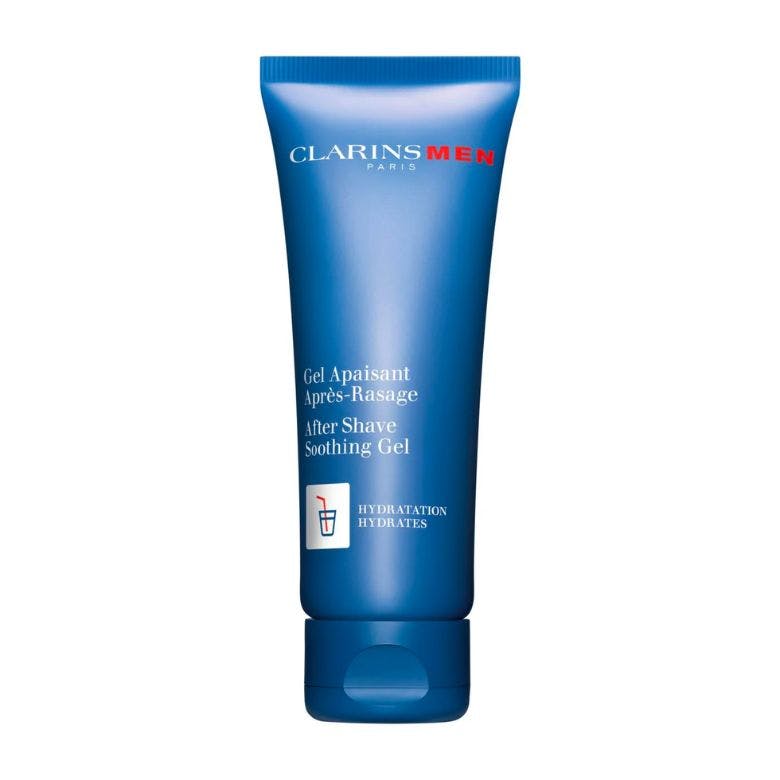Men’s Shaving Guide 101: All You Need to Know
9 minutes read
Growing up, we’re not exactly handed a men’s shaving guide to show us how to do it right, much less tailor it to your individual needs. From those awkward teenage moustache moments to growing your first full (or patchy) beard, many have relied on the grooming information shared by fathers/uncles/best friends from school – which has probably led to a few nicks and burns along the way.

But we’re here to help you and have enlisted the expertise of Samuele Frank Jr Bartolotti, a skilled barber whose own grandfather was known as a ‘master barber’ in his Italian home town. Samuele has honed his skills as a barber across Italy and London, bringing with him his passion for men’s grooming – and with his insider shaving tips, you’ll soon have the sharpest, smoothest shave possible.
Men’s shaving routine
The first thing to note when creating your own shaving routine is that there’s no one-size-fits-all solution. Your hair density, thickness, texture, and growth rate, as well as your desired style, will all differ from others.
It’s important to take note of your individual needs when shaving, so you may need to go through a period of trial and error as you learn what works for you. This may sound like you’re shaving in the dark, but with our tips below, you’ll be equipped with the knowledge to maintain your look and your skin.
Next read: Shaving is part of your overall skincare routine, so read up on our top tips for taking care of men’s skin.
Shaving tips for men
Shaving isn’t just about picking up a razor and scraping it across your face. “There are 3 phases: the pre-shave, shave and post-shave.” explains Samuele, “One should consider skin type, allergies and sensitivity to razor before choosing or applying any products.”
From the pre-shave prep to the tools and the after care, there are steps you need to take to avoid making rookie mistakes that can show in the aftermath – we’re talking acne, ingrown hairs, and redness.

If you are in any doubt – Clarins has a new for 2023 easy guide to choosing products depending on your beard type. Click here to find a prescriptive routine that’s perfect for you.

Skin prep
First things first: make sure your skin and facial hair is clean. “Wash with a splash of hot water followed by an exfoliating cleanser. This will remove excess oil, dead skin cells and open up the pores.” advises Samuele, as your razor can easily become clogged with dead skin cells, excess oils, and other debris, making your shave less effective and more likely to irritate the skin. This is especially important if you have acne, as this can make it worse and potentially lead to infection.
For those with short stubble, use a cleanser that’s suitable for your skin type and needs. If your facial hair is longer than a centimetre, use a specialist beard shampoo to wash and soften your hair.
Once you’ve cleaned up, make sure to keep the area you want to shave wet, as this helps to soften the hair and ease the shaving process.
Select the right tool

As the proverb goes, a bad workman blames his tools – however, in the case of shaving, they really can be the make or break.
The type of tool you use will depend on the style you’re trying to maintain and the closeness you want to achieve. Here are the main shaving tool types to consider:
Disposable razors – This is probably the tool you’re most familiar with. As a general rule, the higher the number of blades, the smoother the shave. Choose ones with stainless steel blades to avoid dulling and blunting, which can cause nicks. These razors should be replaced after every 5-7 uses.
Beard trimmers – Great for achieving a number of cropped looks, beard trimmers are effective for styling as the comb guard can be adjusted for length. You should also use a trimmer if you’re considering moving from a full beard to a smooth shave – don’t go straight in with the razor.
Straight razors – also known as cut throat razors (insert your favourite Sweeney Todd reference here) were predominantly used in the 20th century and made from either stainless steel or carbon steel. Best handled by someone who is practiced with such blades.
Electric razors – Different from beard trimmers, electric razors are for maintaining a smooth shave. These don’t require any shaving product or water as they have rotating blades or cutting blocks that trim the hair closely.
Your tools should be cleaned after every use. Yes, you heard right fellas: every, single, use. Once clean, make sure to store them in a dry area to avoid bacteria growing – don’t leave them in a wet patch on the bathroom sink as we’re all wont to do.
What direction to shave?
The general rule of thumb for shaving direction is to go with the direction of your hair growth. This may mean that you have to move in short spaces. If you have longer hair and can’t see which direction it grows in, crop it first with a beard trimmer so that it’s closer to stubble.
Working in the direction of your hair growth will help reduce the chances of razor bumps, burns, and in-grown hairs. When shaving around the nose and anywhere with tight angles, like the jawline, use a single-blade precision razor. These are often found on the back of disposable razors.
How often is best?
How frequently you shave will depend on how quick your hair regrows. For some this may be once or twice a week, while others will notice that 5 o’clock shadow creeping in at noon.
Shave as often as is needed to maintain your desired style, being sure to follow the necessary pre-, during-, and post-care measures.
Is it best to shave in the morning or at night?
To shave in the morning or at night? To shave before or after a shower? To shave or not to shave? These are all good questions but, alas, with no right or wrong answers. Below are some pros and cons for deciding your daily routine.
Shaving in the morning
Pros:
You start your day off fresh and avoid as much regrowth as possible, especially if you have thick or dark hair that shows easily.
As a morning ritual, shaving can help you feel prepared and ready to take on the day.
Cons:
You’re still tired after just waking up, so running a razor across your face can lead to nicks that you might not get when shaving at a time that you’re more alert.
If you’re susceptible to post-shave redness, this could be more apparent as you start your day. Don’t apply too much pressure while shaving and always follow a calming post-shave care routine.
Shaving at night
Pros:
Many have more time in the evenings, so shaving can be more easily incorporated into a routine. Not rushing means fewer nicks.
Shaving in the evening will allow your skin to restore itself while you sleep, helping to reduce redness and heal any cuts.
Cons:
That 5 o’clock shadow could creep through earlier than expected the next day.
Make shaving part of either your morning or evening routine and you’ll get into a pattern that is easily incorporated. One way to decide is to align it with the time of day you shower, as the warm water helps to soften the hair, making shaving easier.
Shaving products
Just like the tools, not all shaving products are suitable for every man.
Shaving foams and creams will be familiar to most and come in a variety of formats, such as gels that lather when dispensed or in blocks that you whip up with a shaving brush.
There are also more modern innovations such as shaving oils, which can be used before shaving to prep the skin and hair, or as the primary product for a friction-free shave.
The Shave and Beard Oil, £24, is ideal for softening tough hair while providing a protective barrier while shaving to fight against razor burn. It’s also packed with essential oils of rosemary, eucalyptus and mint for healthy hair growth.

Getting the smoothest shave
Want to know how to get the smoothest shave of your life? Follow these 4 steps that Samuele takes to leave his clients feeling smooth and comfortable:
Step 1: Wet your face with a splash of hot water. Follow up with an exfoliating cleanser to remove excess oil, dead skin cells and open up the pores.
Step 2: Pre-shave oil or cream will help soften the hair.
Step 3: Apply shaving cream in a circular motion, so as to lift the hairs up and away from the face. Resulting in a smoother, more precise shave overall.
Step 4: Follow the direction of your hair growth working in short strokes to maximise the amount of hair your razor removes.
Shaving the moustache
We’ve talked about beards but what about the moustache? With a plethora of looks to choose from and a new wave of appreciation hitting the style scene, there’s no time like the present to test drive a ‘tache.
Tips on how to shave a moustache:
- If you’re starting with a full beard, use a trimmer to shorten the hair around your neck, cheeks and chin. This will give your initial moustache shape.
- Take the comb guard off the trimmer and start with the ‘bars’ of the moustache to define its shape further.
- Be careful around the nose area. Use a single precision blade to get under your septum and around the nooks of your nose.
- Use a beard trimmer, not a blade, around your lip line to avoid cuts.
- Clean shave the rest of your face after you’ve achieved the moustache style you wanted.
Post shave care
The job isn’t done until you’ve completed the after care. The final step is one of the most important to ensure you’re not glowing red with post-shave irritation.
Immediately after shaving, apply a lotion to reduce any razor burn and aid skin healing. The After Shave Soothing Gel, £25 has a refreshing, non-sticky formula so you won’t be left looking slick, and also eases redness and irritation.

Add in a moisturiser if skin is dry and always add a SPF as your final step!
Final word from Samuele: change your perspective on self-care. “Once it’s part of your routine, it becomes a priority and an essential for you; Improving confidence, self-esteem and overall wellbeing.”
Next read: Why Men Should Add Bronzer to Their Grooming Game
Sign up for our newsletter
We will keep you in the loop for special offers, exclusive gifts and product news.

